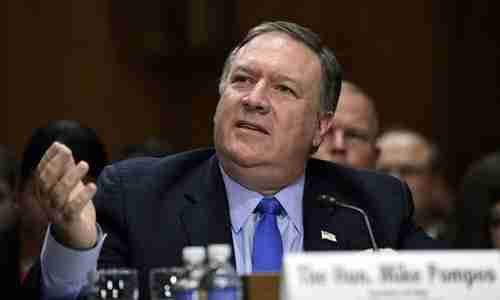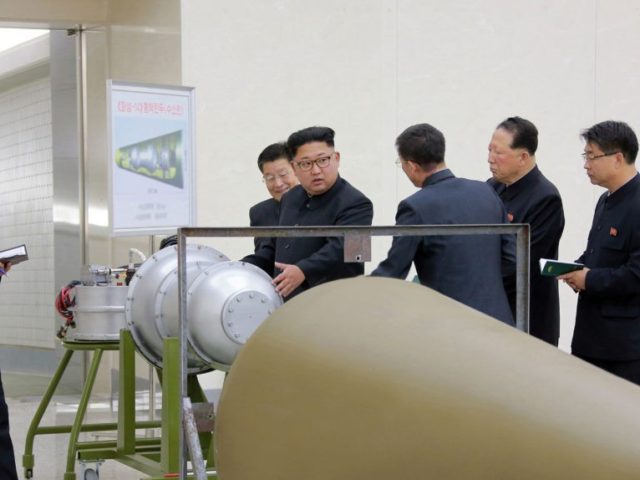This morning’s key headlines from GenerationalDynamics.com
- North Korea appears to dismantle its Sohae satellite launch site
- North Korea’s denuclearization timeline seems to be extending out indefinitely
North Korea appears to dismantle its Sohae satellite launch site

Secretary of State Mike Pompeo testifying to Senate on Wednesday (AP)
Analysis of commercial satellite pictures by the 38 North website shows that North Korea has apparently taken a first step in dismantling facilities at its Sohae satellite launch site.
This site has been used in the past to conduct multiple rocket engine tests, including at least two tests of the engines that ended up powering the first stage of its two flight-tested intercontinental-range ballistic missiles (ICBMs).
According to 38 North analyst Joseph Bermudez:
Since these facilities are believed to have played an important role in the development of technologies for the North’s intercontinental ballistic missile program, these efforts represent a significant confidence building measure on the part of North Korea.
The action is being described as a “confidence building measure,” following the June 12 summit meeting between Donald Trump and Kim Jong-un in Singapore. It is also being described as a step in fulfilling the promises made by Kim Jong-un to Donald Trump during that summit.
Adam Mount, a defense analyst at the Federation of American Scientists, said that North Korea is giving up little in its actions.
Mount was particularly concerned that North Korea did not even invite foreign journalists to watch the dismantling, to verify that it had actually occurred. Instead, the North did whatever it did in broad daylight knowing that it would be detected and reported by analysts like those at 38 North from commercial satellite pictures that show actions on the ground that might be purposely deceptive.
A South Korean official expressed puzzlement for the same reason: “We need further analysis to figure out why the North didn’t turn the dismantlement activities into an event and whether the country is trying to control the speed of the process to maintain a pace it wants.”
Furthermore, it is not clear that anything significant was accomplished at all, according to Mount:
The actions at Sohae are a helpful signal that Pyongyang wants to continue negotiations, but do not in themselves advance nuclear disarmament. North Korea still has not disclosed or offered to dismantle facilities that produce or store nuclear or missile systems, or the means to transport the missiles. So far, the facilities dismantled have been peripheral to these core functions.
According to unnamed US government official referencing assessments by U.S. intelligence agencies, the site “can be reconstituted within months.”
U.S. military intelligence has similarly concluded in May that North Korea’s dismantlement of the tunnel network at the Punggye-ri nuclear test site with explosives was also reversible in a matter of “weeks to months.” In that case, North Korea invited journalists to watch the dismantlement but refused to invite experts who could verify what had happened. There was the possibility that the explosions that occurred at the entrance to the tunnels did not damage the insides of the tunnels. 38 North and AP and The Diplomat
North Korea’s denuclearization timeline seems to be extending out indefinitely
As I have been writing for many months, there is no chance whatsoever that North Korea will give up its nuclear development program now or in the future, after having tortured, starved, and brutalized their own population for three decades, under the promise that one day North Korea would be a nuclear power on a peer with the United States.
North Korea has had only one objective in the charm offensive since the beginning of the year and in Kim’s summit meetings with Trump and South Korean leaders: To get the U.S.-led sanctions lifted without having to give up its development of nuclear missiles targeting the United States.
All of the events since the June 12 summit meeting have been in pursuit of that one objective. Other than two reversible actions, nothing has been done to denuclearize or to end ballistic missile development.
Furthermore, gasoline prices being charged in North Korea have been cut in half since March, suggesting that either China or Russia is supplying petroleum products to North Korea that are in violation of sanctions imposed the U.N. Security Council in December. U.S. officials believe that these and other “maximum pressure” sanctions have forced North Korea to come to the negotiating table. However, a sharp drop in prices could indicate either that the sanctions are not being properly implemented, or that North Korea has found ways internally to adapt to them. Either way, they lose their effectiveness.
The U.S. State Dept. on Monday issued a 17-page advisory listing “deceptive practices” used by the North to bypass the sanctions, including the sending of slave trade abroad. It lists 42 countries where North Korean laborers are still being exploited, including Algeria, Angola, China, Equatorial Guinea, and Russia, adding that the U.S. is monitoring them to see whether they violate UN Security Council resolutions. Washington has also singled out 239 North Korean companies involved in illegal trade and warned against doing business with them.
On Wednesday, U.S. Secretary of State Mike Pompeo testified before the Senate foreign relations committee. He confirmed that North Korea is still producing fissile material for nuclear bombs in spite of its pledge to denuclearize. He declined to respond when asked whether North Korea was continuing to pursue submarine-launched ballistic missiles.
The timeline for North Korea’s denuclearization has yet to be specified, but Pompeo said that the U.S. goal was for North Korea’s complete, verifiable, irreversible denuclearization (CVID) by the end of Trump’s current term in office, which runs until January 2021, “more quickly if possible.” Pompeo said that no sanctions will be listed until CVID is completed. Reuters and Chosun (Seoul) and US State Dept. and Guardian (London)
Related Articles:
- North Korea issues vitriolic anti-US rant, collapsing denuclearization talks (08-Jul-2018)
- Sec of State Pompeo visits North Korea amid reports that sanctions will be softened (06-Jul-2018)
- After the Kim-Trump summit, US and N. Korea plan denuclearization details (14-Jun-2018)
- North Korea suffers diplomatic defeat as Trump cancels summit (25-May-2018)
- North Korea’s negotiating position collapses, along with Mount Mantap (27-Apr-2018)
- NY Times publishes a generational analysis of South Korea (30-Jan-2018)
KEYS: Generational Dynamics, North Korea, South Korea, 38 North, Sohae launch site, Joseph Bermudez, Adam Mount, Federation of American Scientists, Punggye-ri nuclear test site, China, Russia, Mike Pompeo
Permanent web link to this article
Receive daily World View columns by e-mail

COMMENTS
Please let us know if you're having issues with commenting.